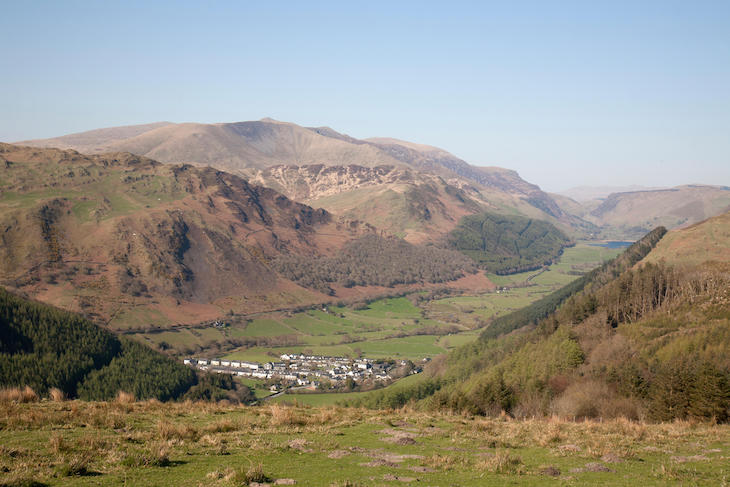You’ve probably never heard of Abergynolwyn, which sits in the Dysynni valley in Merioneth in Wales. The village, established in the nineteenth century to house workers at the nearby Bryn Eglwys slate quarry, is home to just 400 people. But now Abergynolwyn has found its name besmirched by tenuous links to the slave trade.
Abergynolwyn falls within the jurisdiction of Gwynedd council, which manages ‘the slate landscape’ on behalf of Unesco. In April, the council announced that this tiny village must publicly acknowledge its relationship to the slave trade. As part of what Gwynedd council, led by Dyfrig Siencyn (Plaid Cymru), sees as its broader plan to expose the slate landscape’s links to slavery, a plaque advertising the somewhat vague connection will adorn the village hall. ‘Slavery and colonisation form part of the slate story,’ a council spokesperson explained.
What exactly is the link between this small industrial village and slavery?
This news will no doubt come as a surprise to locals. It also came as a surprise to me. As a child, I spent summer holidays with my father’s relatives, who formed a kin network of small tenant farmers across Meirionnydd (aka Merioneth).
This news would also have shocked my grandmother, Ellen Pugh, who lived and died in Abergynolwyn. Ellen profited little from whatever connections the village had to the slave trade. In her will, she left only a Welsh dresser and, as a devoted member of the congregation of the Cwrt chapel, a Welsh bible, Y Beibl, which I still have among my possessions.
So what exactly is the link between this small industrial village and slavery? William McConnel, who built the village at Abergynolwyn to house his workers, was an outstanding example of the principled Victorian entrepreneurs who forged modern Britain. He developed slate quarrying on an industrial scale to the benefit of both his family, his employees and the nation as a whole. As the historian and urban archaeologist, Richard Hayman puts it, McConnel demonstrated ‘how the influence of capitalist owners extended from the workplace to the home in the nineteenth century’.
But McConnel is English and a capitalist to boot. Such a background is anathema to those who currently run Wales and micro-manage the Welsh version of the cultural revolution. From this perspective, McConnel’s achievements must be re-defined to fit an ideology that reduces history to melodrama, where brutal and rapacious English capitalists despoil the Welsh landscape and immiserate its people.
McConnel invested in the slate industry during the American Civil War and the cotton famine that caused the temporary closure of many cloth manufacturing factories across Lancashire. Like all Lancastrian mill owners, McConnel used raw cotton from the plantations of the American South to weave his cloth. The McConnel family owned no slaves, and – as good liberals – supported the struggle for emancipation. Like other manufacturers, he did not attempt to break the naval blockade preventing the export of cotton from the American South and suffered financially as a consequence. Yet the mere fact that the major source of the raw material that fed into McConnel’s mills derived from this tainted source (before the empire developed India and Australia as alternative sources of raw cotton) makes McConnel, the Welsh slate industry and the industrial revolution more generally, guilty by association.
Significantly, in its application for World Heritage Status, Gwynedd council and the Snowdonia National Park Authority did not highlight any slavery links. Instead, in 2017 they commissioned Hayman, to write an ‘urban character study of Abergynolwyn’ which was submitted to Unesco ‘in support of the Wales Slate World Heritage Nomination’. In this well-researched analysis, Hayman finds that ‘Abergynolwyn retains a strong and distinctive nineteenth-century character based on its unique combination of topography, economic and social history, and the local natural resources with which its buildings were constructed’.
It was McConnel’s achievements in pioneering the modern slate industry while preserving the natural beauty of the local landscape that earned the area its World Heritage Status. Yet an alleged connection to the slave trade means this now apparently counts for little. The perverse reasoning, economic illiteracy, historically challenged and duplicitous behaviour of Gwynedd council crystallises the cultural self-loathing that now pervades both the Welsh Labour party and Plaid Cymru.
This, of course, is tendentious and a deliberate distortion of the historical record. It is not history, but ideological posturing that does a disservice to Abergynolwyn and its fascinating past, which needs to be understood in its own terms, not through some anachronistic ideological projection. While such distortion is now firmly entrenched in the Welsh political and educational establishment, the Abergynolwyn case stands out for the thinness of its connection to slavery and the fact that Gwynedd council made no mention of it in its application to Unesco. It made the application on the grounds that McConnel’s endeavours transformed the area positively, but after the iconic status had been granted proceeded to rewrite history to suit its own questionable agenda. This is self-serving and mendacious, but sadly such mendacity is now meat and drink to the cultural enforcers of woke Wales.
David Martin Jones is visiting professor in War Studies at King’s College, London. His latest book is The Strategy of Maoism in the West, co-authored with M.L.R. Smith. A version of this article originally appeared on CIEO






Comments